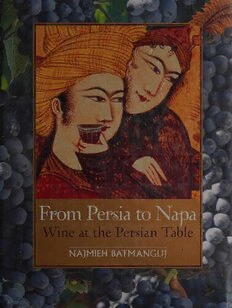
From Persia to Napa: Wine at the Persian Table PDF
Preview From Persia to Napa: Wine at the Persian Table
lDaevea aes la tO < = = < a N ~— aie < Zz U (aa) Yi U From Persia gy Lay Aa. a Wine at the Persian’ lable Wine is seen as the natural partner of many great cuisines, but few people associate it with Persian food, one of the world’s most sophisticated culinary traditions. The ties, in fact, are age-old. From Persia to Napa weaves together history, poetry, a look at modern viniculture, and a wealth of recipes and wine pairings to celebrate the rightful relationship of MiVilalcMrelavemcoletemolamdarom at-1ecit-[ame]elice “Whoever seeks the origins of wine must be elg- VAVAMEE WeMd clesii-laie eXeloiaxedacer-Mel-Tell-Ta-Xe Maina nVAlaTe that simple enjoyment of this greatest gift of the grape ought to be enough. Since he wrote those words, however, winemaking has been traced all the way back to the northern uplands of the Fertile Crescent some seven millennia ago, the start of a journey that would take it across the Near East and then into Europe in the dawning years of civilization. Iran was one of the nurseries of the wine grape, and, as empires rose and fell there, princes, priests, poets and people in ordinary walks of life all embraced wine in various ways. After Islam came to Iran, wine ela alate sometimes slipped from public view, but it never disappeared. In this lavishly illustrated book, NESealicial Batmanglij explores that long and eventful history, then shifts her story to California’s famed Napa Valley, half a world away. There, in a kind of up-to-the-minute homage to the past, an Iranian-American named Darioush Khaledi uses the latest vinicultural techniques to make superb wines at a winery reminiscent of Persepolis, the ceremonial capital of the ancient Persian empire. The final section of the book offers 80 recipes, a guide to Persian hospitality, both old and new, and seasonal menus for various occasions. Grapes play a role in most of the recipes, whether in the form of the fruit, the _ leaf, the juice, the syrup, unripe grapes or their juice (verjuice), vinegar or wine. Although these recipes are presented for the modern table, they are traditional—based on sources as various as a tenth-century Persian cookbook or the culinary archives of a sixteenth-century Persian court. The book has two special sections. One, written by Dick Davis, a leading authority on Persian literature, discusses the unique links -between poetry and wine-drinking in Persian culture. The other, by wine-and-food expert Burke Owens, offers guidelines for pairing wine with the distinctive ingredients used in Persian cooking. He has \ovided wine suggestions for each recipé NY\ sera oe FROM PERSIA TO NAPA WINE AT THE PERSIAN TABLE NAJMIEH BATMANGCLIJ WITH Wine and Persian Poetry Dick Davis Pairing Wine with Persian Food Burke Owens 3.1336 07792 2913 i MAGE PUBLISHERS WASHINGTON, DC 2006 COPYRIGHT © MAGE PUBLISHERS 2006 FULL CREDITS ON PAGES 244-245 ALL RIGHTS RESERVED. NO PART OF THIS BOOK MAY BE REPRODUCED OR RETRANSMITTED IN ANY MANNER WHATSOEVER, EXCEPT IN THE FORM OF A REVIEW, WITHOUT THE WRITTEN PERMISSION OF THE PUBLISHER. LIBRARY OF CONGRESS CATALOGING-IN-PUBLICATION DATA BATMANGLIJ, NAJMIEH FROM PERSIA TO NAPA : WINE AT THE PERSIAN TABLE / NAJMIEH BATMANGLIJ ; WINE AND PERSIAN POETRY [BY] DICK DAVIS ; PAIRING WINE WITH PERSIAN FOOD [BY] BURKE OWENS. P.CM. INCLUDES INDEX. ISBN 1-933823-00-3 (HARDCOVER : ALK. PAPER) 1. COOKERY, IRANIAN. 2. IRAN--SOCIAL LIFE AND CUSTOMS. 3. WINE AND WINE MAKING. |. DAVIS, DICK, 1945- Il. OWENS, BURKE. III. TITLE. TX725.17B365 2006 641.5955--DC22 2006003666 FIRST HARDCOVER EDITION ISBN 1-933823-00-3 PRINTED AND MANUFACTURED IN KOREA MAGE BOOKS ARE AVAILABLE AT BOOKSTORES, THROUGH THE INTERNET OR DIRECTLY FROM THE PUBLISHER: MAGE PUBLISHERS, 1032-29TH STREET, NW, WASHINGTON, DC 20007 202-342-1642 e [email protected] e 800-962-0922 VISIT MAGE ONLINE AT WWW.MAGE.COM ar) To the Persian poets, with admiration and gratitude. With wine beside a gently flowing brook — this is best; Withdrawn from sorrow in some quiet nook — this is best; Our life is like a flower’s that blooms for ten short days, Bright laughing lips, a friendly, fresh-faced look — this is best. Hafez/Davis y) | aes De ga’ “oy tephis Per) i, A 4 St teiy! a eee je?
